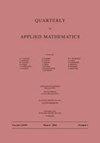求助PDF
{"title":"Toeplitz算子到正态结构距离的一种近似方法","authors":"Elahe Bolourchian, B. A. Kakavandi","doi":"10.1090/QAM/1589","DOIUrl":null,"url":null,"abstract":"<p>A classical theorem from Brown and Halmos asserts that a Toeplitz operator <inline-formula content-type=\"math/mathml\">\n<mml:math xmlns:mml=\"http://www.w3.org/1998/Math/MathML\" alttext=\"upper T left-parenthesis f right-parenthesis\">\n <mml:semantics>\n <mml:mrow>\n <mml:mi>T</mml:mi>\n <mml:mo stretchy=\"false\">(</mml:mo>\n <mml:mi>f</mml:mi>\n <mml:mo stretchy=\"false\">)</mml:mo>\n </mml:mrow>\n <mml:annotation encoding=\"application/x-tex\">T(f)</mml:annotation>\n </mml:semantics>\n</mml:math>\n</inline-formula> is normal if and only if the range of its generator <inline-formula content-type=\"math/mathml\">\n<mml:math xmlns:mml=\"http://www.w3.org/1998/Math/MathML\" alttext=\"f colon double-struck upper T right-arrow double-struck upper C\">\n <mml:semantics>\n <mml:mrow>\n <mml:mi>f</mml:mi>\n <mml:mo>:</mml:mo>\n <mml:mrow class=\"MJX-TeXAtom-ORD\">\n <mml:mi mathvariant=\"double-struck\">T</mml:mi>\n </mml:mrow>\n <mml:mo stretchy=\"false\">→<!-- → --></mml:mo>\n <mml:mrow class=\"MJX-TeXAtom-ORD\">\n <mml:mi mathvariant=\"double-struck\">C</mml:mi>\n </mml:mrow>\n </mml:mrow>\n <mml:annotation encoding=\"application/x-tex\">f:\\mathbb {T}\\rightarrow \\mathbb {C}</mml:annotation>\n </mml:semantics>\n</mml:math>\n</inline-formula> is included in a straight line. In this paper, discretizing <inline-formula content-type=\"math/mathml\">\n<mml:math xmlns:mml=\"http://www.w3.org/1998/Math/MathML\" alttext=\"f left-parenthesis double-struck upper T right-parenthesis\">\n <mml:semantics>\n <mml:mrow>\n <mml:mi>f</mml:mi>\n <mml:mo stretchy=\"false\">(</mml:mo>\n <mml:mrow class=\"MJX-TeXAtom-ORD\">\n <mml:mi mathvariant=\"double-struck\">T</mml:mi>\n </mml:mrow>\n <mml:mo stretchy=\"false\">)</mml:mo>\n </mml:mrow>\n <mml:annotation encoding=\"application/x-tex\">f(\\mathbb {T})</mml:annotation>\n </mml:semantics>\n</mml:math>\n</inline-formula> and using the Principal Component Analysis method to project it onto a ‘best’ line segment in <inline-formula content-type=\"math/mathml\">\n<mml:math xmlns:mml=\"http://www.w3.org/1998/Math/MathML\" alttext=\"upper L squared\">\n <mml:semantics>\n <mml:msup>\n <mml:mi>L</mml:mi>\n <mml:mn>2</mml:mn>\n </mml:msup>\n <mml:annotation encoding=\"application/x-tex\">L^2</mml:annotation>\n </mml:semantics>\n</mml:math>\n</inline-formula>-norm, we propose a numerical method to find the nearest normal Toeplitz operator from <inline-formula content-type=\"math/mathml\">\n<mml:math xmlns:mml=\"http://www.w3.org/1998/Math/MathML\" alttext=\"upper T left-parenthesis f right-parenthesis\">\n <mml:semantics>\n <mml:mrow>\n <mml:mi>T</mml:mi>\n <mml:mo stretchy=\"false\">(</mml:mo>\n <mml:mi>f</mml:mi>\n <mml:mo stretchy=\"false\">)</mml:mo>\n </mml:mrow>\n <mml:annotation encoding=\"application/x-tex\">T(f)</mml:annotation>\n </mml:semantics>\n</mml:math>\n</inline-formula> in the norm <inline-formula content-type=\"math/mathml\">\n<mml:math xmlns:mml=\"http://www.w3.org/1998/Math/MathML\" alttext=\"StartAbsoluteValue StartAbsoluteValue StartAbsoluteValue upper T left-parenthesis f right-parenthesis EndAbsoluteValue EndAbsoluteValue EndAbsoluteValue colon-equal double-vertical-bar f double-vertical-bar Subscript upper L squared left-parenthesis double-struck upper T right-parenthesis\">\n <mml:semantics>\n <mml:mrow>\n <mml:mrow class=\"MJX-TeXAtom-ORD\">\n <mml:mrow>\n <mml:mo>|</mml:mo>\n <mml:mspace width=\"-0.25ex\" />\n <mml:mrow>\n <mml:mo>|</mml:mo>\n <mml:mspace width=\"-0.25ex\" />\n <mml:mrow>\n <mml:mo>|</mml:mo>\n <mml:mi>T</mml:mi>\n <mml:mo stretchy=\"false\">(</mml:mo>\n <mml:mi>f</mml:mi>\n <mml:mo stretchy=\"false\">)</mml:mo>\n <mml:mo>|</mml:mo>\n </mml:mrow>\n <mml:mspace width=\"-0.25ex\" />\n <mml:mo>|</mml:mo>\n </mml:mrow>\n <mml:mspace width=\"-0.25ex\" />\n <mml:mo>|</mml:mo>\n </mml:mrow>\n </mml:mrow>\n <mml:mrow class=\"MJX-TeXAtom-REL\">\n <mml:mo>≔</mml:mo>\n </mml:mrow>\n <mml:mo fence=\"false\" stretchy=\"false\">‖<!-- ‖ --></mml:mo>\n <mml:mi>f</mml:mi>\n <mml:msub>\n <mml:mo fence=\"false\" stretchy=\"false\">‖<!-- ‖ --></mml:mo>\n <mml:mrow class=\"MJX-TeXAtom-ORD\">\n <mml:msup>\n <mml:mi>L</mml:mi>\n <mml:mn>2</mml:mn>\n </mml:msup>\n <mml:mo stretchy=\"false\">(</mml:mo>\n <mml:mrow class=\"MJX-TeXAtom-ORD\">\n <mml:mi mathvariant=\"double-struck\">T</mml:mi>\n </mml:mrow>\n <mml:mo stretchy=\"false\">)</mml:mo>\n </mml:mrow>\n </mml:msub>\n </mml:mrow>\n <mml:annotation encoding=\"application/x-tex\">{\\left \\vert \\kern -0.25ex\\left \\vert \\kern -0.25ex\\left \\vert T(f)\\right \\vert \\kern -0.25ex\\right \\vert \\kern -0.25ex\\right \\vert }\\coloneq \\Vert f \\Vert _{L^2(\\mathbb {T})}</mml:annotation>\n </mml:semantics>\n</mml:math>\n</inline-formula> which is weaker than the operator norm. Besides, we introduce an <italic>index</italic> for the distance from normality of Toeplitz operators which is invariant under the transformations <inline-formula content-type=\"math/mathml\">\n<mml:math xmlns:mml=\"http://www.w3.org/1998/Math/MathML\" alttext=\"f right-arrow from bar a f plus b\">\n <mml:semantics>\n <mml:mrow>\n <mml:mi>f</mml:mi>\n <mml:mo stretchy=\"false\">↦<!-- ↦ --></mml:mo>\n <mml:mi>a</mml:mi>\n <mml:mi>f</mml:mi>\n <mml:mo>+</mml:mo>\n <mml:mi>b</mml:mi>\n </mml:mrow>\n <mml:annotation encoding=\"application/x-tex\">f\\mapsto a f+b</mml:annotation>\n </mml:semantics>\n</mml:math>\n</inline-formula> for all <inline-formula content-type=\"math/mathml\">\n<mml:math xmlns:mml=\"http://www.w3.org/1998/Math/MathML\" alttext=\"a element-of double-struck upper R\">\n <mml:semantics>\n <mml:mrow>\n <mml:mi>a</mml:mi>\n <mml:mo>∈<!-- ∈ --></mml:mo>\n <mml:mrow class=\"MJX-TeXAtom-ORD\">\n <mml:mi mathvariant=\"double-struck\">R</mml:mi>\n </mml:mrow>\n </mml:mrow>\n <mml:annotation encoding=\"application/x-tex\">a\\in \\mathbb {R}</mml:annotation>\n </mml:semantics>\n</mml:math>\n</inline-formula> and <inline-formula content-type=\"math/mathml\">\n<mml:math xmlns:mml=\"http://www.w3.org/1998/Math/MathML\" alttext=\"b element-of double-struck upper C\">\n <mml:semantics>\n <mml:mrow>\n <mml:mi>b</mml:mi>\n <mml:mo>∈<!-- ∈ --></mml:mo>\n <mml:mrow class=\"MJX-TeXAtom-ORD\">\n <mml:mi mathvariant=\"double-struck\">C</mml:mi>\n </mml:mrow>\n </mml:mrow>\n <mml:annotation encoding=\"application/x-tex\">b \\in \\mathbb {C}</mml:annotation>\n </mml:semantics>\n</mml:math>\n</inline-formula> with <inline-formula content-type=\"math/mathml\">\n<mml:math xmlns:mml=\"http://www.w3.org/1998/Math/MathML\" alttext=\"a not-equals 0\">\n <mml:semantics>\n <mml:mrow>\n <mml:mi>a</mml:mi>\n <mml:mo>≠<!-- ≠ --></mml:mo>\n <mml:mn>0</mml:mn>\n </mml:mrow>\n <mml:annotation encoding=\"application/x-tex\">a\\neq 0</mml:annotation>\n </mml:semantics>\n</mml:math>\n</inline-formula>.</p>","PeriodicalId":20964,"journal":{"name":"Quarterly of Applied Mathematics","volume":" ","pages":"1"},"PeriodicalIF":0.9000,"publicationDate":"2021-03-25","publicationTypes":"Journal Article","fieldsOfStudy":null,"isOpenAccess":false,"openAccessPdf":"","citationCount":"0","resultStr":"{\"title\":\"An approximate approach to the structured distance to normality of Toeplitz operators\",\"authors\":\"Elahe Bolourchian, B. A. Kakavandi\",\"doi\":\"10.1090/QAM/1589\",\"DOIUrl\":null,\"url\":null,\"abstract\":\"<p>A classical theorem from Brown and Halmos asserts that a Toeplitz operator <inline-formula content-type=\\\"math/mathml\\\">\\n<mml:math xmlns:mml=\\\"http://www.w3.org/1998/Math/MathML\\\" alttext=\\\"upper T left-parenthesis f right-parenthesis\\\">\\n <mml:semantics>\\n <mml:mrow>\\n <mml:mi>T</mml:mi>\\n <mml:mo stretchy=\\\"false\\\">(</mml:mo>\\n <mml:mi>f</mml:mi>\\n <mml:mo stretchy=\\\"false\\\">)</mml:mo>\\n </mml:mrow>\\n <mml:annotation encoding=\\\"application/x-tex\\\">T(f)</mml:annotation>\\n </mml:semantics>\\n</mml:math>\\n</inline-formula> is normal if and only if the range of its generator <inline-formula content-type=\\\"math/mathml\\\">\\n<mml:math xmlns:mml=\\\"http://www.w3.org/1998/Math/MathML\\\" alttext=\\\"f colon double-struck upper T right-arrow double-struck upper C\\\">\\n <mml:semantics>\\n <mml:mrow>\\n <mml:mi>f</mml:mi>\\n <mml:mo>:</mml:mo>\\n <mml:mrow class=\\\"MJX-TeXAtom-ORD\\\">\\n <mml:mi mathvariant=\\\"double-struck\\\">T</mml:mi>\\n </mml:mrow>\\n <mml:mo stretchy=\\\"false\\\">→<!-- → --></mml:mo>\\n <mml:mrow class=\\\"MJX-TeXAtom-ORD\\\">\\n <mml:mi mathvariant=\\\"double-struck\\\">C</mml:mi>\\n </mml:mrow>\\n </mml:mrow>\\n <mml:annotation encoding=\\\"application/x-tex\\\">f:\\\\mathbb {T}\\\\rightarrow \\\\mathbb {C}</mml:annotation>\\n </mml:semantics>\\n</mml:math>\\n</inline-formula> is included in a straight line. In this paper, discretizing <inline-formula content-type=\\\"math/mathml\\\">\\n<mml:math xmlns:mml=\\\"http://www.w3.org/1998/Math/MathML\\\" alttext=\\\"f left-parenthesis double-struck upper T right-parenthesis\\\">\\n <mml:semantics>\\n <mml:mrow>\\n <mml:mi>f</mml:mi>\\n <mml:mo stretchy=\\\"false\\\">(</mml:mo>\\n <mml:mrow class=\\\"MJX-TeXAtom-ORD\\\">\\n <mml:mi mathvariant=\\\"double-struck\\\">T</mml:mi>\\n </mml:mrow>\\n <mml:mo stretchy=\\\"false\\\">)</mml:mo>\\n </mml:mrow>\\n <mml:annotation encoding=\\\"application/x-tex\\\">f(\\\\mathbb {T})</mml:annotation>\\n </mml:semantics>\\n</mml:math>\\n</inline-formula> and using the Principal Component Analysis method to project it onto a ‘best’ line segment in <inline-formula content-type=\\\"math/mathml\\\">\\n<mml:math xmlns:mml=\\\"http://www.w3.org/1998/Math/MathML\\\" alttext=\\\"upper L squared\\\">\\n <mml:semantics>\\n <mml:msup>\\n <mml:mi>L</mml:mi>\\n <mml:mn>2</mml:mn>\\n </mml:msup>\\n <mml:annotation encoding=\\\"application/x-tex\\\">L^2</mml:annotation>\\n </mml:semantics>\\n</mml:math>\\n</inline-formula>-norm, we propose a numerical method to find the nearest normal Toeplitz operator from <inline-formula content-type=\\\"math/mathml\\\">\\n<mml:math xmlns:mml=\\\"http://www.w3.org/1998/Math/MathML\\\" alttext=\\\"upper T left-parenthesis f right-parenthesis\\\">\\n <mml:semantics>\\n <mml:mrow>\\n <mml:mi>T</mml:mi>\\n <mml:mo stretchy=\\\"false\\\">(</mml:mo>\\n <mml:mi>f</mml:mi>\\n <mml:mo stretchy=\\\"false\\\">)</mml:mo>\\n </mml:mrow>\\n <mml:annotation encoding=\\\"application/x-tex\\\">T(f)</mml:annotation>\\n </mml:semantics>\\n</mml:math>\\n</inline-formula> in the norm <inline-formula content-type=\\\"math/mathml\\\">\\n<mml:math xmlns:mml=\\\"http://www.w3.org/1998/Math/MathML\\\" alttext=\\\"StartAbsoluteValue StartAbsoluteValue StartAbsoluteValue upper T left-parenthesis f right-parenthesis EndAbsoluteValue EndAbsoluteValue EndAbsoluteValue colon-equal double-vertical-bar f double-vertical-bar Subscript upper L squared left-parenthesis double-struck upper T right-parenthesis\\\">\\n <mml:semantics>\\n <mml:mrow>\\n <mml:mrow class=\\\"MJX-TeXAtom-ORD\\\">\\n <mml:mrow>\\n <mml:mo>|</mml:mo>\\n <mml:mspace width=\\\"-0.25ex\\\" />\\n <mml:mrow>\\n <mml:mo>|</mml:mo>\\n <mml:mspace width=\\\"-0.25ex\\\" />\\n <mml:mrow>\\n <mml:mo>|</mml:mo>\\n <mml:mi>T</mml:mi>\\n <mml:mo stretchy=\\\"false\\\">(</mml:mo>\\n <mml:mi>f</mml:mi>\\n <mml:mo stretchy=\\\"false\\\">)</mml:mo>\\n <mml:mo>|</mml:mo>\\n </mml:mrow>\\n <mml:mspace width=\\\"-0.25ex\\\" />\\n <mml:mo>|</mml:mo>\\n </mml:mrow>\\n <mml:mspace width=\\\"-0.25ex\\\" />\\n <mml:mo>|</mml:mo>\\n </mml:mrow>\\n </mml:mrow>\\n <mml:mrow class=\\\"MJX-TeXAtom-REL\\\">\\n <mml:mo>≔</mml:mo>\\n </mml:mrow>\\n <mml:mo fence=\\\"false\\\" stretchy=\\\"false\\\">‖<!-- ‖ --></mml:mo>\\n <mml:mi>f</mml:mi>\\n <mml:msub>\\n <mml:mo fence=\\\"false\\\" stretchy=\\\"false\\\">‖<!-- ‖ --></mml:mo>\\n <mml:mrow class=\\\"MJX-TeXAtom-ORD\\\">\\n <mml:msup>\\n <mml:mi>L</mml:mi>\\n <mml:mn>2</mml:mn>\\n </mml:msup>\\n <mml:mo stretchy=\\\"false\\\">(</mml:mo>\\n <mml:mrow class=\\\"MJX-TeXAtom-ORD\\\">\\n <mml:mi mathvariant=\\\"double-struck\\\">T</mml:mi>\\n </mml:mrow>\\n <mml:mo stretchy=\\\"false\\\">)</mml:mo>\\n </mml:mrow>\\n </mml:msub>\\n </mml:mrow>\\n <mml:annotation encoding=\\\"application/x-tex\\\">{\\\\left \\\\vert \\\\kern -0.25ex\\\\left \\\\vert \\\\kern -0.25ex\\\\left \\\\vert T(f)\\\\right \\\\vert \\\\kern -0.25ex\\\\right \\\\vert \\\\kern -0.25ex\\\\right \\\\vert }\\\\coloneq \\\\Vert f \\\\Vert _{L^2(\\\\mathbb {T})}</mml:annotation>\\n </mml:semantics>\\n</mml:math>\\n</inline-formula> which is weaker than the operator norm. Besides, we introduce an <italic>index</italic> for the distance from normality of Toeplitz operators which is invariant under the transformations <inline-formula content-type=\\\"math/mathml\\\">\\n<mml:math xmlns:mml=\\\"http://www.w3.org/1998/Math/MathML\\\" alttext=\\\"f right-arrow from bar a f plus b\\\">\\n <mml:semantics>\\n <mml:mrow>\\n <mml:mi>f</mml:mi>\\n <mml:mo stretchy=\\\"false\\\">↦<!-- ↦ --></mml:mo>\\n <mml:mi>a</mml:mi>\\n <mml:mi>f</mml:mi>\\n <mml:mo>+</mml:mo>\\n <mml:mi>b</mml:mi>\\n </mml:mrow>\\n <mml:annotation encoding=\\\"application/x-tex\\\">f\\\\mapsto a f+b</mml:annotation>\\n </mml:semantics>\\n</mml:math>\\n</inline-formula> for all <inline-formula content-type=\\\"math/mathml\\\">\\n<mml:math xmlns:mml=\\\"http://www.w3.org/1998/Math/MathML\\\" alttext=\\\"a element-of double-struck upper R\\\">\\n <mml:semantics>\\n <mml:mrow>\\n <mml:mi>a</mml:mi>\\n <mml:mo>∈<!-- ∈ --></mml:mo>\\n <mml:mrow class=\\\"MJX-TeXAtom-ORD\\\">\\n <mml:mi mathvariant=\\\"double-struck\\\">R</mml:mi>\\n </mml:mrow>\\n </mml:mrow>\\n <mml:annotation encoding=\\\"application/x-tex\\\">a\\\\in \\\\mathbb {R}</mml:annotation>\\n </mml:semantics>\\n</mml:math>\\n</inline-formula> and <inline-formula content-type=\\\"math/mathml\\\">\\n<mml:math xmlns:mml=\\\"http://www.w3.org/1998/Math/MathML\\\" alttext=\\\"b element-of double-struck upper C\\\">\\n <mml:semantics>\\n <mml:mrow>\\n <mml:mi>b</mml:mi>\\n <mml:mo>∈<!-- ∈ --></mml:mo>\\n <mml:mrow class=\\\"MJX-TeXAtom-ORD\\\">\\n <mml:mi mathvariant=\\\"double-struck\\\">C</mml:mi>\\n </mml:mrow>\\n </mml:mrow>\\n <mml:annotation encoding=\\\"application/x-tex\\\">b \\\\in \\\\mathbb {C}</mml:annotation>\\n </mml:semantics>\\n</mml:math>\\n</inline-formula> with <inline-formula content-type=\\\"math/mathml\\\">\\n<mml:math xmlns:mml=\\\"http://www.w3.org/1998/Math/MathML\\\" alttext=\\\"a not-equals 0\\\">\\n <mml:semantics>\\n <mml:mrow>\\n <mml:mi>a</mml:mi>\\n <mml:mo>≠<!-- ≠ --></mml:mo>\\n <mml:mn>0</mml:mn>\\n </mml:mrow>\\n <mml:annotation encoding=\\\"application/x-tex\\\">a\\\\neq 0</mml:annotation>\\n </mml:semantics>\\n</mml:math>\\n</inline-formula>.</p>\",\"PeriodicalId\":20964,\"journal\":{\"name\":\"Quarterly of Applied Mathematics\",\"volume\":\" \",\"pages\":\"1\"},\"PeriodicalIF\":0.9000,\"publicationDate\":\"2021-03-25\",\"publicationTypes\":\"Journal Article\",\"fieldsOfStudy\":null,\"isOpenAccess\":false,\"openAccessPdf\":\"\",\"citationCount\":\"0\",\"resultStr\":null,\"platform\":\"Semanticscholar\",\"paperid\":null,\"PeriodicalName\":\"Quarterly of Applied Mathematics\",\"FirstCategoryId\":\"100\",\"ListUrlMain\":\"https://doi.org/10.1090/QAM/1589\",\"RegionNum\":4,\"RegionCategory\":\"数学\",\"ArticlePicture\":[],\"TitleCN\":null,\"AbstractTextCN\":null,\"PMCID\":null,\"EPubDate\":\"\",\"PubModel\":\"\",\"JCR\":\"Q3\",\"JCRName\":\"MATHEMATICS, APPLIED\",\"Score\":null,\"Total\":0}","platform":"Semanticscholar","paperid":null,"PeriodicalName":"Quarterly of Applied Mathematics","FirstCategoryId":"100","ListUrlMain":"https://doi.org/10.1090/QAM/1589","RegionNum":4,"RegionCategory":"数学","ArticlePicture":[],"TitleCN":null,"AbstractTextCN":null,"PMCID":null,"EPubDate":"","PubModel":"","JCR":"Q3","JCRName":"MATHEMATICS, APPLIED","Score":null,"Total":0}
引用次数: 0
引用
批量引用


